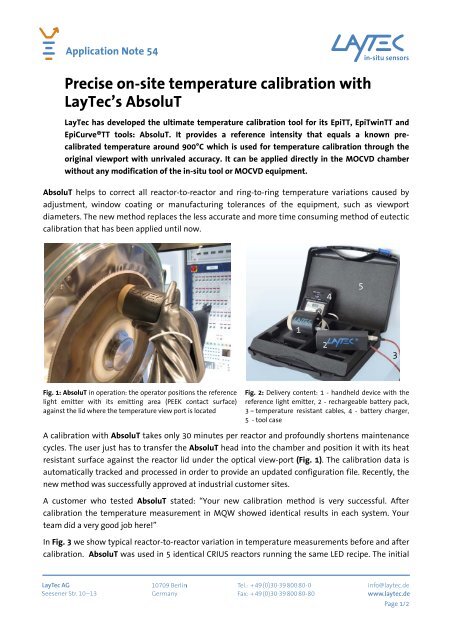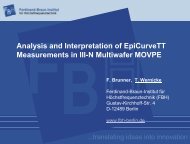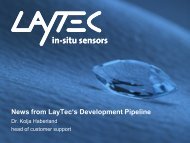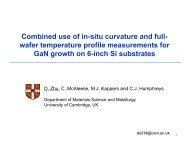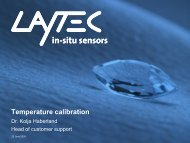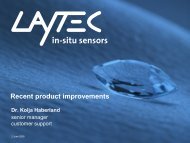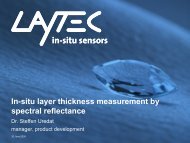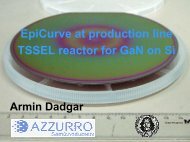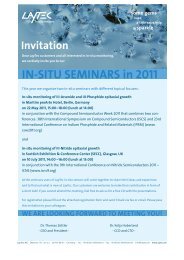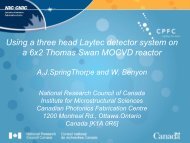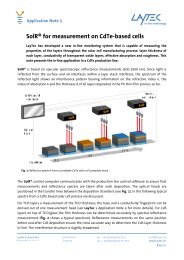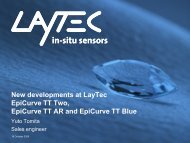Precise on-site temperature calibration with LayTec's AbsoluT
Precise on-site temperature calibration with LayTec's AbsoluT
Precise on-site temperature calibration with LayTec's AbsoluT
Create successful ePaper yourself
Turn your PDF publications into a flip-book with our unique Google optimized e-Paper software.
Applicati<strong>on</strong> Note 54<br />
<str<strong>on</strong>g>Precise</str<strong>on</strong>g> <strong>on</strong>-<strong>site</strong> <strong>temperature</strong> calibrati<strong>on</strong> <strong>with</strong><br />
LayTec’s <strong>AbsoluT</strong><br />
LayTec has developed the ultimate <strong>temperature</strong> calibrati<strong>on</strong> tool for its EpiTT, EpiTwinTT and<br />
EpiCurve®TT tools: <strong>AbsoluT</strong>. It provides a reference intensity that equals a known precalibrated<br />
<strong>temperature</strong> around 900°C which is used for <strong>temperature</strong> calibrati<strong>on</strong> through the<br />
original viewport <strong>with</strong> unrivaled accuracy. It can be applied directly in the MOCVD chamber<br />
<strong>with</strong>out any modificati<strong>on</strong> of the in-situ tool or MOCVD equipment.<br />
<strong>AbsoluT</strong> helps to correct all reactor-to-reactor and ring-to-ring <strong>temperature</strong> variati<strong>on</strong>s caused by<br />
adjustment, window coating or manufacturing tolerances of the equipment, such as viewport<br />
diameters. The new method replaces the less accurate and more time c<strong>on</strong>suming method of eutectic<br />
calibrati<strong>on</strong> that has been applied until now.<br />
Fig. 1: <strong>AbsoluT</strong> in operati<strong>on</strong>: the operator positi<strong>on</strong>s the reference<br />
light emitter <strong>with</strong> its emitting area (PEEK c<strong>on</strong>tact surface)<br />
against the lid where the <strong>temperature</strong> view port is located<br />
Fig. 2: Delivery c<strong>on</strong>tent: 1 - handheld device <strong>with</strong> the<br />
reference light emitter, 2 - rechargeable battery pack,<br />
3 – <strong>temperature</strong> resistant cables, 4 - battery charger,<br />
5 - tool case<br />
A calibrati<strong>on</strong> <strong>with</strong> <strong>AbsoluT</strong> takes <strong>on</strong>ly 30 minutes per reactor and profoundly shortens maintenance<br />
cycles. The user just has to transfer the <strong>AbsoluT</strong> head into the chamber and positi<strong>on</strong> it <strong>with</strong> its heat<br />
resistant surface against the reactor lid under the optical view-port (Fig. 1). The calibrati<strong>on</strong> data is<br />
automatically tracked and processed in order to provide an updated c<strong>on</strong>figurati<strong>on</strong> file. Recently, the<br />
new method was successfully approved at industrial customer <strong>site</strong>s.<br />
A customer who tested <strong>AbsoluT</strong> stated: “Your new calibrati<strong>on</strong> method is very successful. After<br />
calibrati<strong>on</strong> the <strong>temperature</strong> measurement in MQW showed identical results in each system. Your<br />
team did a very good job here!”<br />
In Fig. 3 we show typical reactor-to-reactor variati<strong>on</strong> in <strong>temperature</strong> measurements before and after<br />
calibrati<strong>on</strong>. <strong>AbsoluT</strong> was used in 5 identical CRIUS reactors running the same LED recipe. The initial<br />
1<br />
2<br />
4<br />
5<br />
3<br />
Page 1/2
Applicati<strong>on</strong> Note 54<br />
values (black) were gained <strong>with</strong> reference to the black body pre-calibrati<strong>on</strong> before shipment. They<br />
are obviously higher than the real <strong>temperature</strong> because the viewport aperture used during the black<br />
body calibrati<strong>on</strong> differs from the real aperture in operati<strong>on</strong>. The head-to-head or reactor-to-reactor<br />
variati<strong>on</strong>s are in the range of ± 7.5 K.<br />
Fig. 3: Temperature measurements in 5 identical reactors<br />
before calibrati<strong>on</strong> (black) and after calibrati<strong>on</strong> (red).<br />
As the original viewport of the MOCVD system is<br />
not available at LayTec for pre-calibrati<strong>on</strong>, <strong>on</strong><strong>site</strong><br />
variati<strong>on</strong>s of the viewport diameter<br />
(typically in the range of 10 %) cannot be<br />
corrected. The viewport aperture, however,<br />
affects <strong>temperature</strong> sensing in CRIUS type of<br />
reactors significantly because the intensity of<br />
the IR radiati<strong>on</strong> detected by the pyrometer<br />
changes if the view-port diameter differs. The<br />
new <strong>AbsoluT</strong> calibrati<strong>on</strong> completely eliminates<br />
these effects: after <strong>temperature</strong> calibrati<strong>on</strong><br />
(red), the correct <strong>temperature</strong> of 760°C was<br />
measured and the <strong>temperature</strong> variati<strong>on</strong> of ± 1.3<br />
K was validated by identical photoluminescence<br />
(PL) emissi<strong>on</strong> wavelength of the wafers from all<br />
5 reactors.<br />
Fig. 4: <strong>temperature</strong> measurement <strong>with</strong> EpiTwin TT in a CRIUS reactor before and after calibrati<strong>on</strong> <strong>with</strong><br />
<strong>AbsoluT</strong>: the red line shows the calibrati<strong>on</strong> point.<br />
inner ring<br />
outer ring<br />
Fig. 4 shows <strong>temperature</strong> measurements performed <strong>with</strong> LayTec’s double-head sensor EpiTwin TT.<br />
Before calibrati<strong>on</strong> <strong>with</strong> <strong>AbsoluT</strong> a <strong>temperature</strong> offset of 4 K between the inner and outer ring was<br />
visible (left from the vertical red line). After the calibrati<strong>on</strong> both <strong>temperature</strong> curves are in<br />
agreement and there are no ring-to-ring <strong>temperature</strong> differences anymore.<br />
Calibrati<strong>on</strong> <strong>with</strong> <strong>AbsoluT</strong> is a must for establishing stable producti<strong>on</strong> c<strong>on</strong>diti<strong>on</strong>s <strong>with</strong>in narrow<br />
device specificati<strong>on</strong>s. It enables the absolute accuracy of <strong>temperature</strong> measurement in the range of<br />
±1K, improves data quantity and quality for process c<strong>on</strong>trol and reactor-to-reactor supervisi<strong>on</strong> and<br />
allows a faster feedback resp<strong>on</strong>se for failure analysis. Besides, the easy use of the tool reduces down<br />
times during maintenance intervals. Calibrati<strong>on</strong> <strong>with</strong> <strong>AbsoluT</strong> is essential to all customers who want<br />
to compare the <strong>temperature</strong> measured in-situ in different reactors.<br />
<strong>AbsoluT</strong> is available to all LayTec customers using EpiTT, EpiTwinTT and EpiCurve®TT tools in<br />
AIXTRON Planetary® and CRIUS reactors.<br />
Versi<strong>on</strong> 20101220<br />
Page 2/2


